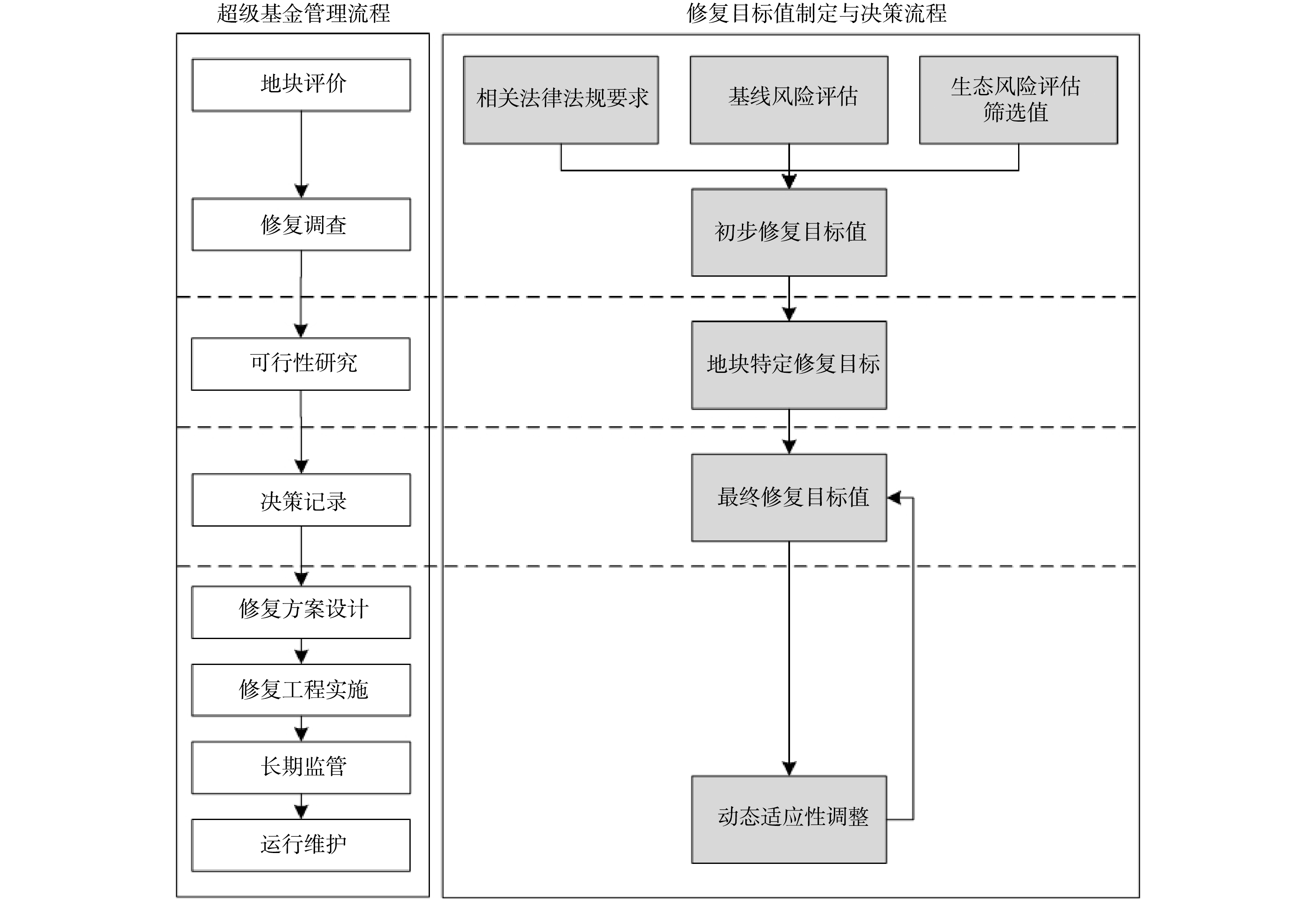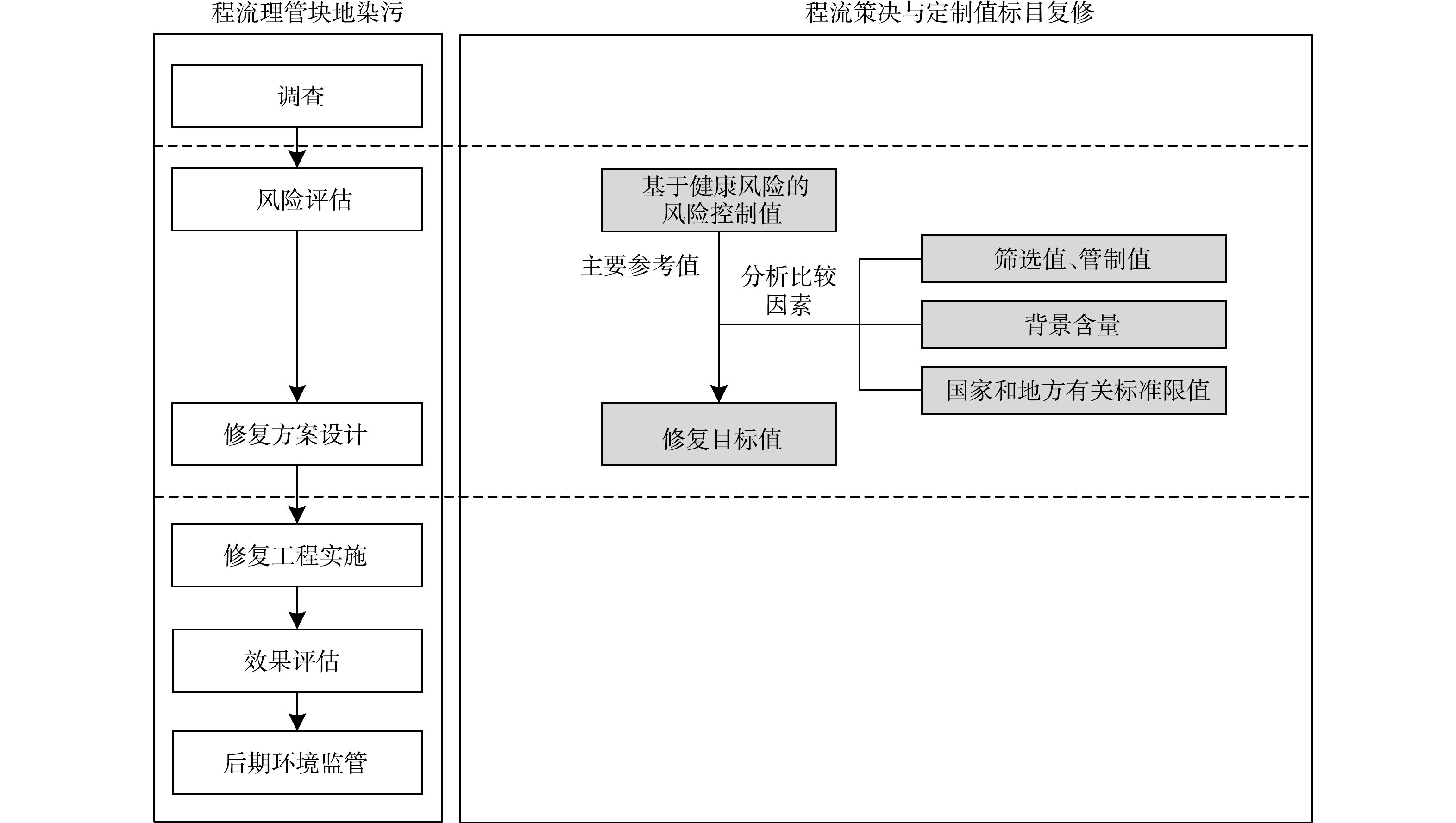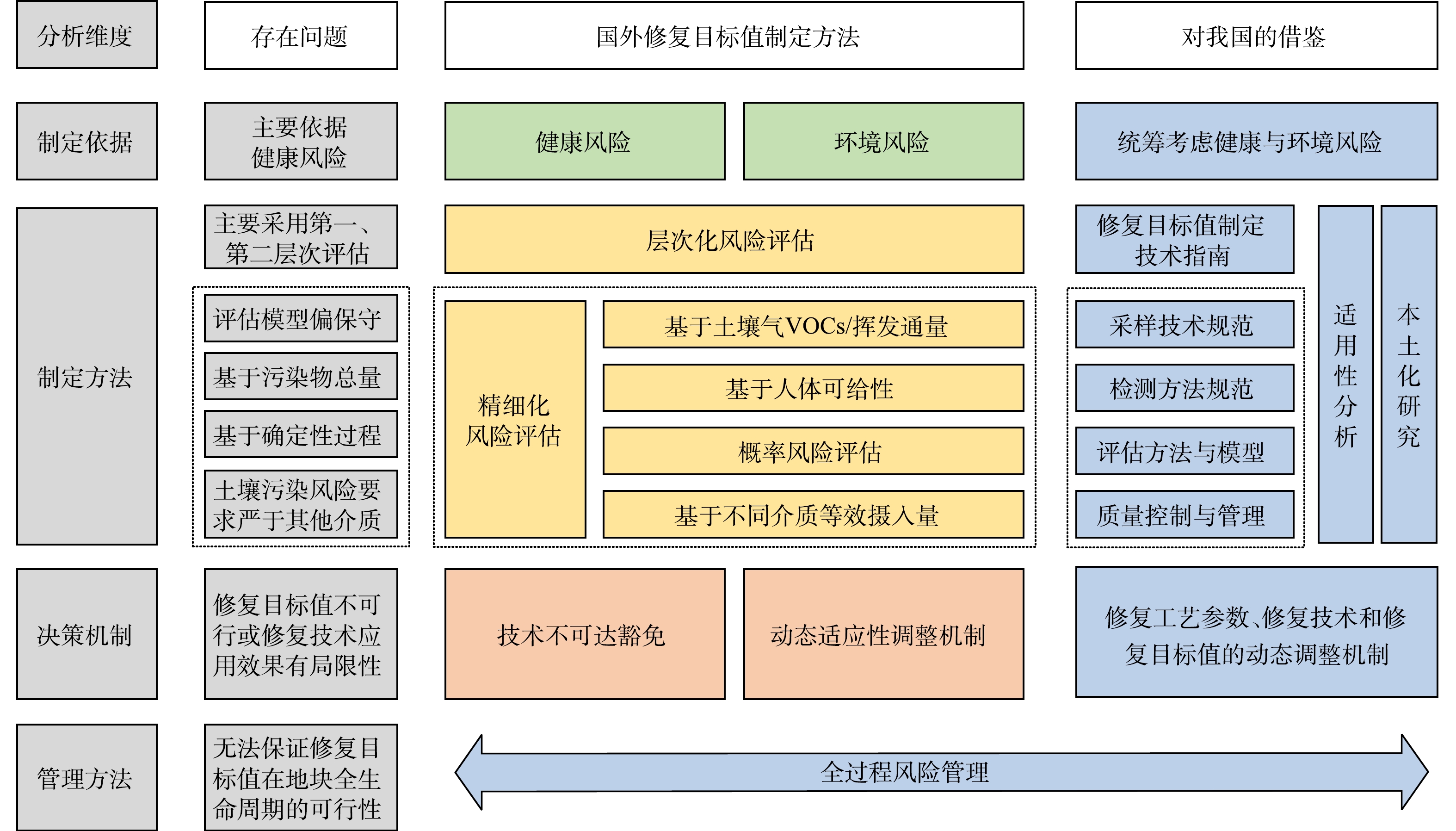-
传统工业企业由于环境管理粗放,可能存在跑冒滴漏,导致土壤和地下水受到污染[1],进而对人群健康和周边环境造成影响。根据《污染地块土壤环境管理办法》[2]规定,经风险评估确认风险超过可接受水平的污染地块,需开展治理与修复,并在工程完工后进行效果评估。修复目标值作为污染修复终点,是确定修复范围和工程量的主要依据,也是修复效果的评估标准值,更是污染地块环境管理的重要决策依据[3-4]。因此,科学制定合理的修复目标值是污染地块实现可持续修复的前提。
纵观美国、英国、加拿大和澳大利亚等国家的污染地块环境管理体系,均综合考虑土壤污染对人体健康和环境产生不利影响的总体控制要求[5-7],根据具体地块情况和各利益方诉求分层次进行风险评估制定修复目标值[8-9],修复目标值随概念模型研究的逐渐深化不断做动态适用性调整,且实行全过程风险管理机制[10],保证修复目标值在地块全生命周期内的可行性。我国现已建立污染场地健康风险评估技术标准体系[3-4,11],修复目标值亦是依据健康风险评估方法,采用确定性模型,基于污染物总量来确定[1,12],且实行的是把修复目标值作为固定评价限值的管理机制[12],未考虑污染物在环境中赋存形态对暴露途径和毒性效应的影响,低估或高估了健康风险[1,13],影响了修复目标值制定的合理性[13],且难以应对复杂污染地块管理中不确定性挑战[12,14]。
通过对比分析国内外修复目标值的内在含义、制定的技术方法和决策机制,研究我国污染地块环境管理的管理需求,并提出统筹考虑人体健康风险和环境风险,结合层次化与精细化风险评估、动态优化和基于全过程风险管理的修复目标值制定方法体系,以期为我国污染场地土壤修复目标值的科学合理制定提供借鉴。
-
欧美发达国家针对污染地块修复终点提出了定性的修复目标和定量的修复目标值两层含义[5,15-17]。修复目标是宏观层面的总体目标,是制定定量修复目标值的依据,包括两方面:一是控制土壤污染对环境的影响或符合相关法律法规的要求;二是保障人体健康风险达到的致癌和非致癌效应可接受水平。修复目标值是特定场地满足修复目标需达到的污染物含量限值,用于指导修复工程实践。
-
第一和第二层次风险评估因是基于污染物总量和确定性模型,未考虑污染物形态归趋,导致计算结果过于保守,影响修复目标值的合理性。SMITH等[18-19]研究发现,基于土壤浓度和模型平衡假设计算VOCs风险的结果过于保守;ABREU等[20]开发了基于土壤气VOCs浓度的风险评估模型,以降低VOCs风险评估的保守性。美国、英国、加拿大等对VOCs污染地块采用了层次化风险管理思路,相继发布了针对基于土壤气VOCs浓度/挥发通量的调查与评估系列技术导则,包括土壤气体采样技术、通量测试技术、样品分析标准方法、数据分析与评估方法等[21-24]。RUBY等[25]研究发现,基于土壤中污染物总量评估重金属和半挥发有机物风险的结果过于保守;WRAGG等[26]认为以生物有效性作为暴露剂量进行评估更符合客观实际。但由于动物试验周期长、成本高、结果重现性差且存在伦理问题,RUBY等[27]和WRAGG等[28]开发了体外模拟人体胃肠消化过程的可给性测试方法。美国、德国等已发布土壤污染物人体可给性测试方法及验证评估的技术规范[29-31],美国等发布了基于人体可给性的风险评估技术指南[32]。由于不同方法的可给性测试结果存在差异[33],WRAGG等[28]提出了体外可给性测试与动物试验结果对比的验证方法和有效性要求,以保证可给性测试结果的适用性。风险评估模型参数的不确定性分布会导致评估结果过于保守,影响评估决策的科学性[34],美国环境保护局 (US EPA) 对此提出了概率风险评估方法[35],将土壤污染物浓度分布及人体暴露参数的不确定性纳入评估过程,采用蒙特卡洛等随机模拟方法计算参数不同取值情景下对应的修复目标值,避免高估或低估风险。此外,英国提出了基于不同环境介质等效摄入量的土壤中砷等污染物修复目标值的计算方法,如依据饮用水标准限值和人群暴露参数计算不同介质的等效允许摄入量,以此为基础结合暴露情景确定土壤修复目标值,以平衡土壤与其他介质中污染风险的控制水平[36]。国外土壤污染修复目标值制定技术路径详见表1。
欧美国家的研究和场地实践证明了层次化和精细化风险评估方法的可靠性,典型案例见表2。由表2可见,随着风险评估层次的不断深入,评估结果的保守性逐渐降低,即修复目标值、风险值有随评估层次的增加呈逐渐升高的趋势。采用层次化与精细化风险评估方法,考虑污染物在土壤中的形态归趋、生物有效性等因素影响,可避免基于污染物总量、确定性过程、参数的固定理论值进行风险评估结果偏保守的问题,制定的修复目标值更符合地块客观实际情况[15]。
-
由于场地水文地质条件的非均质性和污染物形态归趋的复杂性,场地调查、风险评估以及修复方案编制阶段存在较大不确定性,影响了评估决策的可靠性[12]。美国、英国等建立了基于全过程风险管理的修复目标值制定决策机制,在风险评估、修复方案编制、修复实施等阶段,不断更新场地概念模型,根据修复目标值的可行性与可达性,对修复工艺和修复目标值进行优化调整[9-10]。
以美国超级基金的管理体系为例 (见图1) ,在调查评估阶段,根据基线风险评估、相关法律法规要求 (applicable or relevant and appropriate requirements, ARARs) 和生态风险评估的结果确定初步修复目标值 (preliminary remediation goals, PRGs) ,用于支撑修复方案的编制[5]。在修复方案可行性研究阶段,筛选最优修复方案,确定最优方案相应的修复目标 (remediation action objectives, RAOs) [39]。在决策记录阶段,结合环境影响、技术经济可行性和利益相关方接受程度等因素,确定最终修复目标值 (final cleanup levels) [40]。在修复实施过程中,针对存在难降解污染物且污染面积大、水文地质条件复杂等情况的复杂地块,可根据修复过程的跟踪监测与实际效果评估,对修复工艺参数、修复技术和修复目标值进行动态调整[12],以保证总体修复目标的实现。
-
综合对比国内外修复目标值的内涵、制定流程和方法,我国对于定性修复目标的定义和欧美国家总体一致,《中华人民共和国土壤污染防治法》第二条对土壤污染的定义涵盖了对人体健康和环境造成的风险[41],《建设用地土壤污染风险管控和修复术语》(HJ 682—2019)[42]明确规定了修复目标包括保护人体健康和生态受体。《建设用地土壤污染风险评估技术导则》(HJ 25.3—2019) [11]规定,具体地块修复目标值的制定主要依据健康风险评估结果,确定人体健康风险达到可接受水平的土壤修复终点值。但未考虑土壤中污染物通过淋溶、挥发等作用向地下水、地表水和空气等环境介质迁移的影响,未将环境风险的控制要求纳入修复目标值制定的决策因素,在实践中出现“土壤健康风险可接受,其他介质环境质量不符合相关标准要求”或“修复地块的异味物质扩散影响相邻场地暴露人群”等现象[12,43],可见,仅考虑健康风险难以保证总体修复目标的实现。
对于健康风险的修复目标值,我国和欧美等国均是采用基于风险管理的制定思路,将风险评估模型计算的风险控制值作为主要参考值,综合筛选值和管制值标准、地块背景含量等,确定修复目标值[3,11]。但国家现行风险评估技术导则采用基于污染物总量、确定性过程、部分评估参数为固定理论值的方法[44],未考虑污染物在土壤中的形态归趋对暴露途径、毒性和人体 (生物) 可给性的影响[1,13],未明确采用层次化和精细化风险评估方法。据不完全统计,全国仅约2%的地块采用了精细化风险评估方法制定修复目标值,实践中大多直接把筛选值或使用导则推荐公式和参数推算的风险控制值 (基本等于筛选值) 作为修复目标值,存在评估结果过于保守的情况[1,13],导致过度修复和经济的浪费。目前,仅北京市地方技术导则 (DB 11/T 656—2019《建设用地土壤污染状况调查与风险评估技术导则》) [45],明确规定了基于污染物形态归趋的层次化与精细化风险评估方法的应用。
-
针对我国风险评估存在的问题,国内学者开展了层次化和精细化风险评估方法的研究,主要集中在以下几个方面。
1) 基于土壤气VOCs实测浓度和挥发通量的风险评估方法研究。姜林等[46]和MA等[47]均开展了基于土壤气VOCs浓度的风险评估方法研究,李卫东等[48]开展了基于土壤气挥发通量的风险评估方法研究。上述研究结果表明,基于土壤气VOCs实测浓度和挥发通量的风险评估结果更为客观,比传统基于土壤浓度和模型假设计算的风险低1~3个数量级;挥发通量对于评估一定区域的整体风险水平更加稳定,能够一定程度上避免基于土壤浓度采用模型计算带来的偶然性结果,但通量测试应充分考虑时间-空间波动性影响,优化测试方法保证测试结果的时空代表性。ZHANG等[49-50]提出适用于我国居住建筑结构特征的VOCs一维衰减源模型 (SD模型) 和J&E-DED(Johnson & Ettinger-dual equilibrium desorption)模型,与现有模型相比提高了计算结果的精确度。
2) 基于人体 (生物) 可给性的风险评估方法研究。范婧婧等[51-53]针对钢铁、冶炼等行业污染地块土壤中重金属和多环芳烃,根据人体可给性的测试结果确定修复目标值,一定程度上解决了基于污染物总量的风险评估结果过于保守的问题。LI等[33]综合分析了国内外研究中重金属的体外人体可给性测试与动物试验生物有效性之间的相关关系,验证了体外人体可给性测试方法的适用性。
3) 概率风险评估方法研究。XIA等[54-55]采用概率风险评估方法,量化了暴露参数、土壤理化性质参数等不确定性因素对健康风险水平的影响,优化了风险评估结果和修复目标值,相比于传统确定性风险评估方法更加客观。
4) 层次化多证据风险评估方法研究。陈卓等[44]、ZHONG等[56]和JIANG等[57]针对汞、镍等污染地块,提出了基于土壤污染物形态归趋-有效剂量-健康效应的精细化风险评估技术框架,提出了结合污染物形态、人体 (生物) 可给性和概率风险评估等多证据的修复目标值制定方法。ACCORNERO等[58]提出了利用概率分析和地统计学方法确定地块污染物的背景水平,作为重金属修复目标值制定的参考依据。
5) 基于地下水环境保护的土壤修复目标值制定方法研究。陈梦舫等[59]和刘鹏超等[60]提出了基于保护地下水环境的风险评估模拟方法。
目前国内已开展了层次化与精细化风险评估方法的场地应用实践。由表3可见,采用精细化风险评估方法制定的修复目标值相比第二层次计算结果提高了1~3个数量级,一定程度上解决了现有评估方法过于保守的问题;同时发现,修复目标值制定结果不仅取决于地块特征条件、暴露情景、污染物及其赋存形态、风险评估层次等因素,还受到测试方法与评估模型等影响。国内实践案例中存在可给性测试方法与评估模型不统一、概率分布类型与取值不一致,以及缺乏有效性评价方法等情况。由于不同的测试方法与评估模型得到的结果通常并不完全一致[33],需要建立标准化、重复性好的方法体系。国家层面尚未发布土壤气/挥发通量的采样技术与检测方法[61]、土壤污染物人体可给性检测方法、概率风险评估方法,以及数据分析与质量控制等方面的技术规范,精细化风险评估方法的大规模推广应用仍受到一定限制。
-
复杂污染场地调查、评估结果存在较大的不确定性[10,12],可能导致修复目标值不具有技术经济可行性或修复技术应用效果存在局限性,无法达到修复目标值要求的客观情况。相比美、英等国提出的污染场地动态适应性管理框架,我国采用修复目标值作为固定评价限值的线性化管理方法,缺少修复工艺参数、修复技术和修复目标值的动态调整机制,难以应对复杂污染场地不确定性的挑战[1,12],详见图2。
目前,在修复实施和效果评估阶段,基于风险的管理思路未得到充分体现,尚缺乏污染土壤修复极限的判定方法,也未建立修复过程中间产物和残留污染物的风险评估方法[4],这就使得修复目标值动态优化调整缺少依据。应结合污染物-途径-受体的关系,不断更新概念模型,客观评价土壤污染的健康风险和环境风险,通过修复目标值制定、调整和效果评价等环节落实基于风险的管理思路,形成贯穿污染地块环境管理全过程的可持续风险管理机制。
-
我国污染地块修复工作由最初地块再开发利用的经济利益驱动,发展为地块再开发与环保督查的经济、政策双重驱动,并将逐渐转变为在产企业防范环境管理风险的内在驱动,绿色可持续修复的实际需求日益增长,也对修复目标值科学合理制定提出了更高的要求。结合我国国情,选择借鉴吸收国外制定修复目标值制定方法、决策机制等方面的成功经验,有利于促进我国污染地块可持续修复的发展进程 (见图3) 。针对不同污染规模和污染复杂程度,在保障地块潜在暴露人群健康和周边环境安全的前提下,考虑污染物的形态归趋,选择采用层次化和精细化风险评估方法,制定地块特征的修复目标值,并采用动态适应性调整机制和全过程的风险管理思路,保证总体修复目标的实现,可有力推动绿色可持续修复的发展。
另外,由于国内外不同区域土壤、气候、水文、地质等自然条件特点,人群的生活方式、生活习惯和体貌特征[1]、居住建筑结构[48]等方面的差异,需对国外的精细化风险评估模型和参数开展适用性分析和本土化研究,结合我国国情进行优化调整,以保证修复目标值制定方法的适用性和有效性。
-
1)污染地块土壤修复目标值的制定应以防止对潜在暴露人群和周边环境敏感目标产生不利影响为目的,统筹考虑潜在暴露人群的健康风险和地块对周边敏感目标的环境风险。
2)结合我国人群暴露特点和土地利用方式,进一步开展基于土壤中污染物形态归趋和迁移转化的精细化风险评估理论与方法研究,形成采样技术、检测方法、评估方法与质量控制措施等系列技术规范,建立基于层次化、精细化风险评估的修复目标值制定方法体系。
3)充分考虑场地水文地质条件的非均质性和污染物形态归趋的复杂性、风险评估模型与参数的不确定性,以及修复技术的局限性等因素,在保障总体修复目标实现的前提下,构建修复目标值动态适应性调整机制。
4)以保障人体健康和环境风险可接受为总体目标,将风险管理作为地块环境管理决策依据,并贯穿于污染地块管理的全过程。
场地土壤修复目标值制定方法与政策
A study on methodology and policies for developing soil remediation target value of contaminated sites
-
摘要: 土壤污染物修复目标值的制定是污染场地环境管理的重要环节,制定科学合理的修复目标值是能否实现绿色可持续修复的关键。通过对比分析美国、英国、加拿大、澳大利亚等国家修复目标值的内涵、制定技术方法和决策管理机制,发现国内外关于土壤污染物修复的总体目标基本一致,即以保护人体健康和生态环境质量作为总体控制要求;但对于具体场地的定量修复目标值,国内外在制定依据、制定方法、决策管理机制等方面存在差异。我国主要在健康风险评估阶段,采用第一和第二层次风险评估方法确定修复目标值,而欧美国家主要基于全过程风险管理的决策管理机制,结合土壤中污染物的形态归趋和迁移转化规律,采用不同层次的风险评估,制定地块特征的修复目标值,保证健康风险和环境风险均达到可接受水平。借鉴国外经验,结合我国污染地块环境管理实践,提出土壤污染物修复目标值制定方法优化的建议:1) 统筹考虑人体健康风险和环境风险;2) 建立基于层次化、精细化的风险评估与修复目标值确定方法体系;3) 构建修复目标值动态适应性调整机制;4) 形成污染地块全过程风险管理机制。Abstract: Development of soil remediation target values (SRTVs) is an important aspect of contaminated sites management, and reasonable remediation target values are the basis for supporting sustainable site remediation decisions. In this study, the definitions, methodologies and decision mechanisms for developing SRTVs in some developed countries such as the United States, United Kingdom, Canada and Australia were scrutinized and addressed. It was found that the definitions of remediation goals were generally identical between countries as well as domestic and abroad. Protection of human health and environmental quality was usually the remediation objectives. However, there were dissimilarities in developing quantitative target values for specific sites in terms of scientific and management basis, development methods, and determination mechanisms. In China, SRTVs were developed in tier 1 and tier 2 phases of risk assessment for human health. However, the development of SRTVs in developed countries involved a whole process of risk management. The fate and transport of soil contaminants and their speciations would be considered and multi-tiers of risk assessment were performed to develop SRTVs in specific sites. Both human health and environmental risks should be warranted and acceptable risk obtained. Referring to the experiences of developed countries and considering to the practical aspects of China in contaminated sites management, some suggestions for developing and improving SRTVs in specific sites were proposed, including: (1) A full consideration of both health risk and environmental risk in the development of SRTVs, (2) tiered and refined risk assessment approaches should be used, (3) the adoptive adjustment strategy should be established in developing and refining SRTVs, and (4) a risk management concept should be included and applied throughout the entire remediation process.
-
表 1 国外土壤污染修复目标值制定技术路径
Table 1. Technical route of setting remediation target value for soil in contaminated sites
表 2 国外污染地块土壤污染精细化风险评估典型案例
Table 2. International case study of refined risk assessment for contaminated sites
精细化评估方法 评估地块 关注污染物 方法与参数 第三层次与第二层次修复目标值的比值 基于土壤气VOCs实测浓度/挥发通量 美国新泽西州皮卡汀尼兵工厂[18] 三氯乙烯 基于土壤气VOCs实测浓度 1~3个数量级 美国加州汽油泄漏场地[19] 苯 基于土壤气VOCs实测浓度和挥发通量,考虑生物降解作用 3~5个数量级 美国劳伦斯·利弗莫尔国家实验室场地[19] 三氯乙烯 基于土壤气VOCs实测浓度和挥发通量 2个数量级 基于人体 (生物) 可给性 美国俄勒冈州某铅锌冶炼厂[27] 铅 PBET(physiologically based extraction test) 3.8 美国犹他州某铅锌冶炼厂[27] 铅 PBET 4.5 英国11个煤制气厂[37] 多环芳烃 RIVM(rijksinstituut voor volksgezondheid en milieu), SHIME(simulated human intestinal microbial ecosystem) 1.7~10.0 概率风险评估 意大利波维萨煤制气厂[38] 苯系物 采用蒙特卡罗方法评估暴露参数的不确定性 1.1 (苯) 1.6 (甲苯) 基于不同环境介质等效摄入量 英国土壤砷指导值[36] 砷 基于饮用水中砷等效摄入量 47.0 (住宅用地) 213.3 (商业用地) 表 3 国内污染地块土壤污染精细化风险评估典型案例
Table 3. Domestic case study of refined risk assessment for contaminated sites
精细化评估方法 评估地块 关注污染物 方法与参数 第三层次与第二层次修复目标值的比值 基于土壤气VOCs实测浓度/挥发通量 江苏某化工厂[48] 氯代烃 J&E-DED模型 (基于土壤浓度) 1~3个数量级 基于土壤气挥发通量 2.1 北京某焦化厂[46] 苯 J&E模型 (基于土壤气实测浓度) 10.0 基于人体 (生物) 可给性 黑龙江某氯碱企业[44] 汞 PBET 7.5 北京某焦化厂等4个地块[51] 多环芳烃 DIN(deutsches institut für normung) 23.9~83.5 (地块BJ) 14.5~18.2 (地块SD) 7.3~8.9 (地块BG) 2.0 (地块DL) 湖南某冶炼厂[52] 砷、镉、铜、铅、锌 PBETIVG(in vitro gastrointesinal method) 1.2~1.8 (砷) 1.4~1.7 (镉) 1.3~1.7 (铜) 1.0~1.1 (铅) 1.2~1.4 (锌) 天津某制药厂[56] 镍 UBM(the unified bioaccessibility method), IBM(inhalation bioaccessibility method) 3.0 概率风险评估 北京某焦化厂[54] 苯系物、多环芳烃 蒙特卡罗方法评估暴露参数与理化性质参数的不确定性 1.9 (萘) 2.4 (苯并[a]芘) -
[1] 周友亚, 姜林, 张超艳, 等. 我国污染场地风险评估发展历程概述[J]. 环境保护, 2019, 47(8): 34-38. doi: 10.14026/j.cnki.0253-9705.2019.08.009 [2] 中华人民共和国生态环境部. 污染地块土壤环境管理办法(试行)[EB/OL]. [2016-12-31]. https://www.mee.gov.cn/gkml/hbb/bl/201701/t20170118_394953.htm [3] 中华人民共和国生态环境部. 建设用地土壤修复技术导则: HJ 25.4—2019[S]. 北京: 中国环境科学出版社, 2019. [4] 中华人民共和国生态环境部. 污染地块风险管控与土壤修复效果评估技术导则: HJ 25.5—2018[S]. 北京: 中国环境出版社, 2018. [5] US Environmental Protection Agency. Risk-assessment guidance for Superfund. Volume 1. Human Health Evaluation Manual (Part B, Development of Risk-Based Preliminary Remediation Goals). Interim report[R]. Washington DC: Office of Emergency and Remedial Response, 1991. [6] Canadian Council of Ministers of the Environment. Guidance manual for developing site-specific soil quality remediation objectives for contaminated sites in Canada[R]. Winnipeg: Canadian Council of Ministers of the Environment, 1996. [7] Cooperative Research Centre for Contamination Assessment and Remediation of the Environment. National remediation framework: guideline on establishing remediation objectives[R]. Adelaide: Cooperative Research Centre for Contamination Assessment and Remediation of the Environment, 2019. [8] American Society for Testing and Materials. ASTM E2081-00(2015), Standard guide for risk-based corrective action[S]. West Conshohocken, PA, USA: American Society for Testing and Materials, 2015. [9] Department for Environment Food and Rural Affairs. Model procedures for the management of land contamination[R]. Bristol: UK Environment Agency, 2004. [10] Interstate Technology & Regulatory Council. Remediation management of complex sites: RMCS-1[R]. Washington DC: Interstate Technology & Regulatory Council, 2017. [11] 中华人民共和国生态环境部. 建设用地土壤污染风险评估技术导则: HJ 25.3—2019[S]. 北京: 中国环境科学出版社, 2019. [12] 姜林, 梁竞, 钟茂生, 等. 复杂污染场地的风险管理挑战及应对[J]. 环境科学研究, 2021, 34(2): 458-467. doi: 10.13198/j.issn.1001-6929.2020.07.14 [13] 姜林, 樊艳玲, 钟茂生, 等. 我国污染场地管理技术标准体系探讨[J]. 环境保护, 2017, 45(9): 38-43. doi: 10.14026/j.cnki.0253-9705.2017.09.008 [14] LEE M H, TRUEX M, FRESHLEY M, et al. Idaho national laboratory test area north: application of endpoints to guide adaptive remediation at a complex site[J]. Remediation Journal, 2016, 26(4): 11-25. doi: 10.1002/rem.21483 [15] RODRIGUES S M, PEREIRA M E, da SILVA E F, et al. A review of regulatory decisions for environmental protection: part I—challenges in the implementation of national soil policies[J]. Environment International, 2009, 35(1): 202-213. doi: 10.1016/j.envint.2008.08.007 [16] CAREY M A, MARSLAND P A, SMITH J W N. Remedial targets methodology: hydrogeological risk assessment for land contamination[R]. Bristol: UK Environmental Agency, 2006. [17] VOLCHKO Y, BERGGREN KLEJA D, BACK P E, et al. Assessing costs and benefits of improved soil quality management in remediation projects: a study of an urban site contaminated with PAH and metals[J]. Science of the Total Environment, 2020, 707: 135582. doi: 10.1016/j.scitotenv.2019.135582 [18] SMITH J A, CHIOU C T, KAMMER J A, et al. Effect of soil moisture on the sorption of trichloroethene vapor to vadose-zone soil at Picatinny Arsenal, New Jersey[J]. Environmental Science & Technology, 1990, 24(5): 676-683. [19] MCNEEL P J, DIBLEY V. Case study comparisons of vapor inhalation risk estimates: ASTM RBCA model predictions vs site specific soil vapor data[R]. Washington DC: Lawrencen Livermore National Laboratory, 1997. [20] ABREU L D V, JOHNSON P C. Effect of vapor source-building separation and building construction on soil vapor intrusion as studied with a three-dimensional numerical model[J]. Environmental Science & Technology, 2005, 39(12): 4550-4561. [21] US Environmental Protection Agency. OSWER Technical guide for assessing and mitigating the vapor intrusion pathway from subsurface vapor sources to indoor air[R]. Washington DC: US Environmental Protection Agency, 2015. [22] Interstate Technology & Regulatory Council. Vapor intrusion pathway: A practical guideline[R]. Washington DC: Interstate Technology & Regulatory Council, 2007. [23] Construction Industry Research and Information Association. VOCs handbook: investigating, assessing and managing risks from inhalation of VOCs at land affected by contamination[R]. London: Construction Industry Research and Information Association, 2009. [24] Canadian Council of Ministers of the Environment. PN 1555, Guidance manual for environmental site characterization in support of environmental and human health risk assessment[S]. Winnipeg: Canadian Council of Ministers of the Environment, 2016. [25] RUBY M V, SCHOOF R, BRATTIN W, et al. Advances in evaluating the oral bioavailability of inorganics in soil for use in human health risk assessment[J]. Environmental Science & Technology, 1999, 33(21): 3697-3705. [26] WRAGG J, CAVE M. In-vitro methods for the measurement of the oral bioaccessibility of selected metals and metalloids in soils: a critical review[R]. Nottingham: British Geological Survey, 2002. [27] RUBY M V, DAVIS A, SCHOOF R, et al. Estimation of lead and arsenic bioavailability using a physiologically based extraction test[J]. Environmental Science & Technology, 1996, 30(2): 422-430. [28] WRAGG J, CAVE M, BASTA N, et al. An inter-laboratory trial of the unified BARGE bioaccessibility method for arsenic, cadmium and lead in soil[J]. Science of the Total Environment, 2011, 409(19): 4016-4030. [29] US Environmental Protection Agency. EPA 9200.2-86, Standard operating procedure for an in vitro bioaccessibility assay for lead in soil[S]. Washington DC: US Environmental Protection Agency, 2008. [30] Deutsches Institut für Normung. DIN 19738-2017, Soil quality-bioaccessibility of organic and inorganic pollutants from contaminated soil material[S]. Berlin: Deutsches Institut für Normung, 2017. [31] US Environmental Protection Agency. Validation assessment of in vitro lead bioaccessibility assay for predicting relative bioavailability of lead in soils and soil-like materials at superfund sites[R]. Washington DC: US Environmental Protection Agency, 2017. [32] US Environmental Protection Agency. OSWER 9285.7-80, Guidance for evaluating the oral bioavailability of metals in soils for use in human health risk Assessment[S]. Washington DC: US Environmental Protection Agency, 2007. [33] LI H B, LI M Y, ZHAO D, et al. Arsenic, lead, and cadmium bioaccessibility in contaminated soils: measurements and validations[J]. Critical Reviews in Environmental Science and Technology, 2020, 50(13): 1303-1338. doi: 10.1080/10643389.2019.1656512 [34] VISCUSI W K, HAMILTON J T, DOCKINS P C. Conservative versus mean risk assessments: implications for superfund policies[J]. Journal of Environmental Economics and Management, 1997, 34(3): 187-206. doi: 10.1006/jeem.1997.1012 [35] US Environmental Protection Agency. Risk assessment guidance for Superfund: Volume III - Part A, Process for conducting probabilistic risk assessment[R]. Washington DC: US Environmental Protection Agency, 2001. [36] MARTIN I, BURCA R D, MORGAN H. Soil guideline values for inorganic arsenic in soil[R]. Bristol: UK Environment Agency, 2009. [37] CAVE M R, WRAGG J, HARRISON I, et al. Comparison of batch mode and dynamic physiologically based bioaccessibility tests for PAHs in soil samples[J]. Environmental Science & Technology, 2010, 44(7): 2654-2660. [38] BONOMO L, CASERINI S, POZZI C, et al. Target cleanup levels at the site of a former manufactured gas plant in northern Italy: deterministic versus probabilistic results[J]. Environmental Science & Technology, 2000, 34(18): 3843-3848. [39] US Environmental Protection Agency. EPA/540/G-89/004, Guidance for conducting remedial investigations and feasibility studies under CERCLA[S]. Washington DC: US Environmental Protection Agency, 1988. [40] US Environmental Protection Agency. A guide to preparing Superfund proposed plans, records of decision, and other remedy selection decision documents[R]. Washington DC: UK Environment Agency, 1999. [41] BROMBAL D, WANG H Y, PIZZOL L, et al. Soil environmental management systems for contaminated sites in China and the EU. Common challenges and perspectives for lesson drawing[J]. Land Use Policy, 2015, 48: 286-298. doi: 10.1016/j.landusepol.2015.05.015 [42] 中华人民共和国生态环境部. 建设用地土壤污染风险管控和修复术语: HJ 682—2019[S]. 北京: 中国环境科学出版社, 2019. [43] 马杰. 我国挥发性有机污染地块调查评估中存在的问题及对策建议[J]. 环境工程学报, 2021, 15(1): 3-7. doi: 10.12030/j.cjee.202007080 [44] 陈卓, 张丹, 吴志远, 等. 基于形态及生物可给性的汞污染场地概率风险[J]. 环境科学研究, 2021, 34(11): 2748-2756. doi: 10.13198/j.issn.1001-6929.2021.07.11 [45] 北京市市场监督管理局. 建设用地土壤污染状况调查与风险评估技术导则: DB11/T 656—2019[S]. 北京: 北京市市场监督管理局, 2019. [46] 姜林, 钟茂生, 梁竞, 等. 层次化健康风险评估方法在苯污染场地的应用及效益评估[J]. 环境科学, 2013, 34(3): 1034-1043. doi: 10.13227/j.hjkx.2013.03.031 [47] MA J, MCHUGH T, BECKLEY L, et al. Vapor intrusion investigations and decision-making: a critical review[J]. Environmental Science & Technology, 2020, 54(12): 7050-7069. [48] 李卫东, 张超艳, 郭晓欣, 等. 基于土壤气挥发通量的污染场地三氯甲烷健康风险评估[J]. 生态毒理学报, 2021, 16(1): 87-96. [49] ZHANG R H, JIANG L, ZHONG M S, et al. A source depletion model for vapor intrusion involving the influence of building characteristics[J]. Environmental Pollution, 2019, 246: 864-872. doi: 10.1016/j.envpol.2018.12.035 [50] ZHANG R H, JIANG L, ZHONG M S, et al. Applicability of soil concentration for VOC-contaminated site assessments explored using field data from the Beijing-Tianjin-Hebei urban agglomeration[J]. Environmental Science & Technology, 2019, 53(2): 789-797. [51] 范婧婧, 周友亚, 王淑萍, 等. 基于DIN测试的场地土壤PAHs生物可给性及健康风险研究[J]. 环境科学研究, 2020, 33(11): 2629-2638. doi: 10.13198/j.issn.1001-6929.2020.05.48 [52] 冯康宏, 范缙, Lik Ung Stanley Hii, 等. 基于生物可给性的某冶炼厂土壤重金属健康风险评价[J]. 中国环境科学, 2021, 41(1): 442-450. doi: 10.3969/j.issn.1000-6923.2021.01.050 [53] ZHANG R H, HAN D, JIANG L, et al. Derivation of site-specific remediation goals by incorporating the bioaccessibility of polycyclic aromatic hydrocarbons with the probabilistic analysis method[J]. Journal of Hazardous Materials, 2020, 384: 121239. doi: 10.1016/j.jhazmat.2019.121239 [54] XIA T X, JIANG L, JIA X Y, et al. Application of probabilistic risk assessment at a coking plant site contaminated by polycyclic aromatic hydrocarbons[J]. Frontiers of Environmental Science & Engineering, 2014, 8(3): 441-450. [55] GUO P, LI H M, ZHANG G M, et al. Contaminated site-induced health risk using Monte Carlo simulation: evaluation from the brownfield in Beijing, China[J]. Environmental Science and Pollution Research International, 2021, 28(20): 25166-25178. doi: 10.1007/s11356-021-12429-4 [56] ZHONG M S, JIANG L. Refining health risk assessment by incorporating site-specific background concentration and bioaccessibility data of Nickel in soil[J]. Science of the Total Environment, 2017, 581-582: 866-873. doi: 10.1016/j.scitotenv.2017.01.036 [57] JIANG L, ZHANG R H, ZHANG L N, et al. Improving the regulatory health risk assessment of mercury-contaminated sites[J]. Journal of Hazardous Materials, 2021, 402: 123493. doi: 10.1016/j.jhazmat.2020.123493 [58] ACCORNERO M, JIANG L, NAPOLI E, et al. Probability distributions of arsenic in soil from brownfield sites in Beijing (China): statistical characterization of the background populations and implications for site assessment studies[J]. Frontiers of Environmental Science & Engineering, 2015, 9(3): 465-474. [59] 陈梦舫, 韩璐, 罗飞. 污染场地土壤与地下水风险评估方法学[M]. 北京: 科学出版社, 2017. [60] 刘朋超, 武文培, 冉睿予, 等. 基于保护水环境的场地地下水风险评估模拟应用研究[J]. 土壤, 2022, 54(1): 136-144. doi: 10.13758/j.cnki.tr.2022.01.018 [61] 马杰. 土壤气监测在污染地块调查评估中的优势、局限及解决思路[J]. 环境工程学报, 2021, 15(8): 2531-2535. doi: 10.12030/j.cjee.202011091 -





 下载:
下载:



